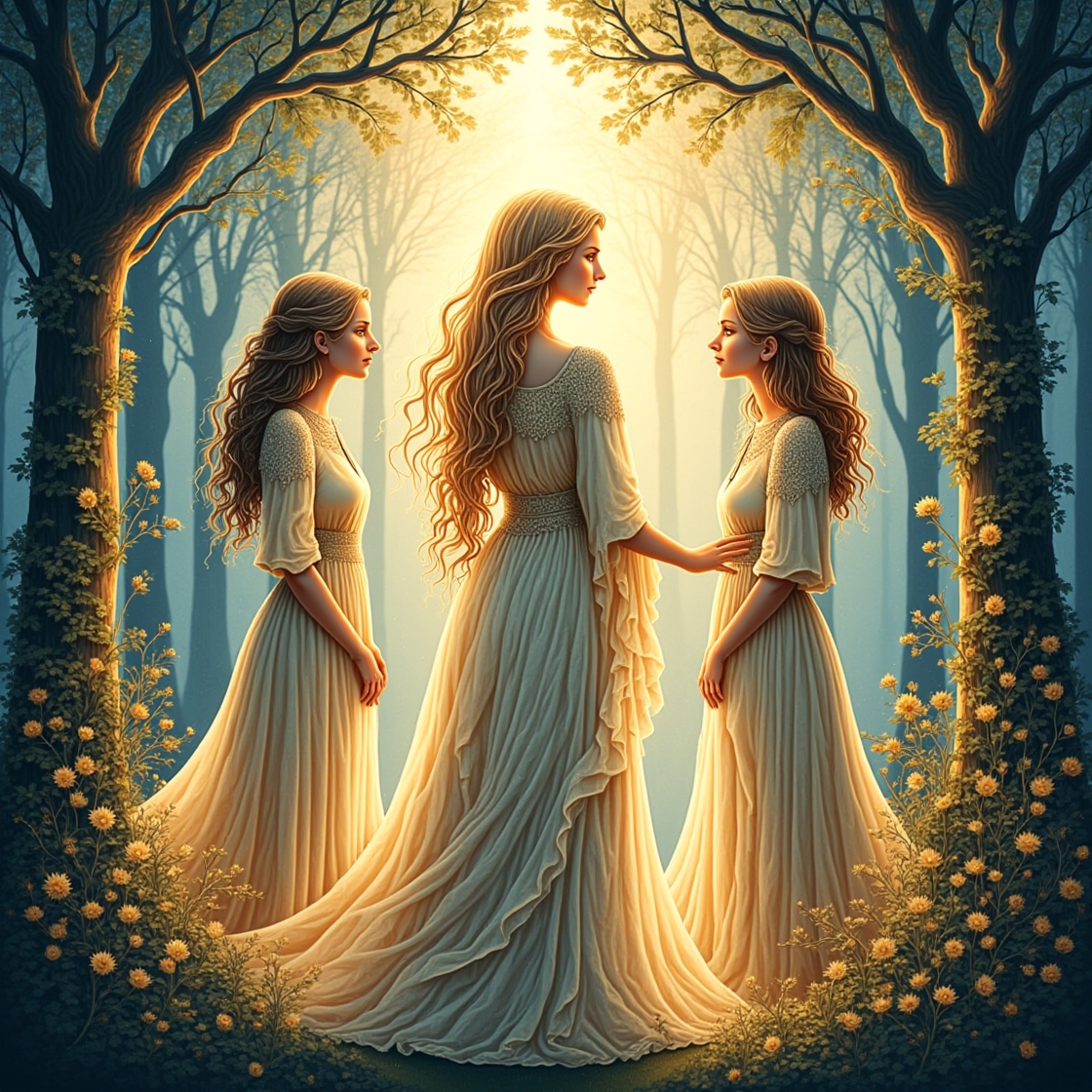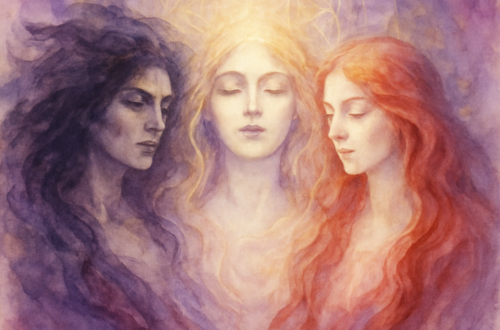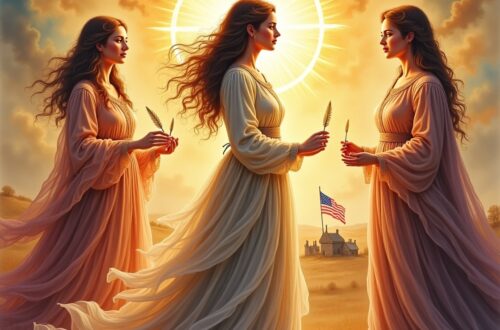
The Divine Feminine and Esoteric Christianity in Tolkien and Lewis’s Mythical Realms
Within the enchanted pages of Middle-Earth and Narnia breathes a sacred mystery-one that pulses with divine feminine energy and draws from wells of esoteric Christian tradition. J.R.R. Tolkien and C.S. Lewis, luminaries of the Oxford literary group known as the Inklings, crafted worlds that transcend mere fantasy, becoming vessels for spiritual awakening and divine remembrance. Their works, while appearing as magical adventures on the surface, contain deeper currents of sacred wisdom that continue to nourish souls seeking spiritual enlightenment.
The Sacred Foundation of the Inklings
The Inklings gathered in Oxford pubs and college rooms, sharing their writings and spiritual insights during a time when the modern world was increasingly turning away from the mystical. Both Tolkien and Lewis stood as guardians of an ancient spiritual flame, weaving their profound faith into tapestries of myth that would speak to generations.
From The Desk of Archives of Inquiry is a reader-supported publication. To receive new posts and support my work, consider becoming a free or paid subscriber.
Tolkien, a devout Catholic, once wrote that The Lord of the Rings was “a fundamentally religious and Catholic work; unconsciously so at first, but consciously in the revision”[1]. Yet his approach transcended conventional religious expression. “That is why I have not put in, or have cut out, practically all references to anything like ‘religion,’ to cults or practices, in the imaginary world. For the religious element is absorbed into the story and the symbolism”[2]. This subtle infusion allowed spiritual truths to bypass intellectual barriers, speaking directly to the soul.
Lewis, who journeyed from atheism to Christianity, carried with him a surprising openness to mystical experience. Though not considering himself a mystic, Lewis was “far more interested in mysticism and even the occult than many people imagine”[3]. His spiritual quest included encounters with what he called “Joy”-transcendent moments of longing that pointed beyond themselves to divine reality.
Galadriel: Embodiment of the Divine Feminine
In Tolkien’s mythology, perhaps no character more perfectly embodies the divine feminine than Galadriel, Lady of Lothlórien. Her creation reveals Tolkien’s deep appreciation for the sacred feminine principle as expressed through Marian theology. Tolkien himself acknowledged, “I think it is true that I owe much of this character to Catholic teaching and imagination about Mary”[4].
Galadriel represents the journey of feminine consciousness, from Eve to Mary, embodying what Catholic theologians call “the feminine genius.” She stands as “the most maternal of the female characters. She is a protector, intercessor and moral guide. She gives encouragement and hope to the Ring-bearer and his companions”[5]. Her penetrating gaze sees beyond exteriors into souls, reflecting the compassionate wisdom of divine feminine consciousness.
The journey of Galadriel beautifully mirrors the spiritual evolution of the feminine soul. As St. Edith Stein said, “Every other woman has something in herself inherited from Eve, and she must search for a way from Eve to Mary”[6]. Galadriel’s story in The Silmarillion and The Lord of the Rings traces this very path-from rebellion to redemption, from pride to sacred surrender. Her moment of refusing the One Ring represents the triumph of divine feminine wisdom over the temptation of power.
Tolkien describes her as “the mightiest and fairest of all the Elves that remained in Middle-earth”[7], connecting her to an ancient lineage. This elevation of feminine power within his mythology stands as a profound counterbalance to the masculine-dominated narratives of his time.
Lewis and the Mystical Feminine in Narnia
While Tolkien worked within a distinctly Catholic framework, Lewis drew from a broader spectrum of Christian mysticism. In Lewis’s vision, the divine feminine appears most powerfully through the characters of Lucy and Susan Pevensie, who represent different aspects of spiritual receptivity and relationship with the divine.
Lewis’s interest in mysticism infused his Narnia chronicles with what David Downing calls an “appreciation for, and engagement with, the mystical way”[8]. His feminine characters often serve as intuitive channels to the divine, particularly young Lucy, whose childlike openness makes her especially receptive to Aslan’s presence.
Lucy embodies the mystical virtue of spiritual sight-seeing what others cannot. Her consistent ability to perceive Aslan when others fail reflects the biblical truth that spiritual realities are often revealed to the childlike and pure of heart. Susan, by contrast, represents a more complex feminine journey-one that includes skepticism and eventual distancing from Narnia, perhaps symbolizing the challenges of maintaining mystical awareness in a materialistic world.
The divine feminine in Lewis’s work also appears through celestial influences. Michael Ward’s groundbreaking work Planet Narnia reveals how Lewis structured each Narnia book around one of the seven medieval planets, each with its distinct spiritual personality[9]. This cosmological framework draws on ancient esoteric associations between planetary spheres and divine attributes, creating a multi-layered spiritual reality within Narnia.
Esoteric Christianity: The Hidden Stream
Both Tolkien and Lewis drew from esoteric Christian traditions while remaining orthodox in their personal faith. Tolkien’s deep knowledge of Norse mythology allowed him to transform pagan elements into vehicles for Christian truth. “As a Christian, Tolkien rejected much of the Norse world outlook, but admired its imaginative power. Those elements that he could transform into Christian meaning, he kept”[10].
This transformative approach allowed Tolkien to create what might be called a “baptized mythology”-one that retained the numinous power of ancient stories while reorienting them toward Christian spiritual truths. His cosmology, particularly as outlined in The Silmarillion, establishes a spiritual hierarchy reminiscent of traditional angelic orders, with Eru Ilúvatar (God), the Valar (angelic powers), and the Maiar (lesser angels including Gandalf)[11].
Lewis similarly engaged with esoteric traditions, particularly in his Space Trilogy, where he explores the nature of gender beyond physical manifestation. In Perelandra, Lewis writes of beings who are “sexless. But he of Malacandra was masculine (not male); she of Perelandra was feminine (not female)”[12]. This distinction points to a deeper understanding of masculine and feminine principles as cosmic realities beyond biological sex-an insight shared by many esoteric Christian traditions.
The Elven Bloodline: Spiritual Heritage
The esoteric dimensions of Tolkien’s work extend to his concept of the Elves, beings whose spiritual awareness and connection to divine reality far exceed those of mortals. Some readers have even felt personal resonance with this elevated consciousness: “Some people simply feel a resonance with elves and intuitively sense they have elven blood. DNA memory could be calling, tugging at your awareness”[13].
While this perspective might seem fanciful, it speaks to the profound spiritual recognition many readers experience when encountering Tolkien’s Elves. Their immortality, wisdom, and connection to nature embody qualities of awakened consciousness that many spiritual seekers aspire to cultivate.
Within Tolkien’s mythology, the Elves represent a higher state of being-one that maintains conscious connection with divine reality while experiencing the material world. Galadriel’s realm of Lothlórien manifests this consciousness, creating a sacred space where time flows differently and ordinary awareness shifts toward the eternal.
The Sacred Tree: Qabalic Influences
Both authors drew on Qabalic concepts of divine emanation-the idea that creation flows from the One Source through various levels of manifestation. In Tolkien’s legendarium, this appears in the creation story of Eru Ilúvatar singing the world into being through the Ainur. In Lewis’s work, it emerges in the structured cosmology of the heavenly spheres.
The Qabalic Tree of Life provides an interesting lens for understanding the spiritual geography of both authors’ worlds. In Qabalic teaching, “Kether is the source of all things. Kether contains all things that were and all things that will be. Kether is the Divine breath that started all creation”[14]. This concept parallels Tolkien’s Ilúvatar and the Great Music that brings forth Middle-Earth.
Similarly, the journey through Narnia often involves ascension through levels of being-from the mundane world to increasingly sacred realms, culminating in Aslan’s Country. This vertical movement mirrors the Qabalic understanding of spiritual progression up the Tree of Life toward divine union.
Conclusion: Sacred Legacy
The works of Tolkien and Lewis continue to resonate deeply because they speak not just to our minds but to our spiritual DNA. Their stories activate remembrance of divine truths that lie dormant within us. Through characters like Galadriel and Lucy, they reveal pathways of feminine spiritual awakening that complement and complete masculine spiritual journeys.
As we read their works with awakened awareness, we can recognize the invitation they extend-to remember our own divine heritage, to harmonize masculine and feminine principles within ourselves, and to participate in the great cosmic dance of creation. Their legacy isn’t merely literary but transformative, offering maps for our own journeys of spiritual awakening in an age that desperately needs reconnection with sacred reality.
The divine feminine flows through their stories like a healing river, nourishing parched souls and reminding us of the compassionate wisdom that balances and completes divine masculine strength. By embracing both principles, as Tolkien and Lewis did in their mythologies, we open ourselves to wholeness and spiritual integration-the true heart of esoteric Christianity and the enduring gift of the Inklings’ magical worlds.
Citations:
[1] https://churchlifejournal.nd.edu/articles/is-tolkiens-writing-fundamentally-religious-and-catholic/
[2] https://churchlifejournal.nd.edu/articles/is-tolkiens-writing-fundamentally-religious-and-catholic/
[3] https://www.ivpress.com/into-the-region-of-awe
[4] https://www.dawsoncentre.org/2022/02/06/the-feminine-genius-in-the-lord-of-the-rings/
[5] https://www.dawsoncentre.org/2022/02/06/the-feminine-genius-in-the-lord-of-the-rings/
[6] https://www.lightfromlight.org/literature/the-feminine-journey
[7] https://en.wikipedia.org/wiki/Galadriel
[8] https://www.ivpress.com/into-the-region-of-awe
[9] https://reformedperspective.ca/the-hidden-meaning-of-the-chronicles-of-narnia/
[10] https://gratefultothedead.com/2010/10/11/tolkiens-christianity-an-insightful-essay/
[11] https://unconventional.ink/mysticism-and-tolkien/
[12] https://www.acton.org/religion-liberty/volume-33-number-4/cs-lewis-and-apocalypse-gender
[13] https://www.northernway.org/weblog/?p=16
[14] https://northernway.org/school/electives/qabalah/qabalah34.html





